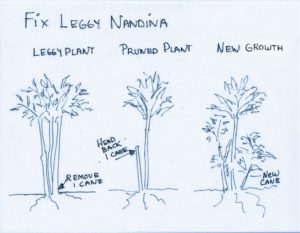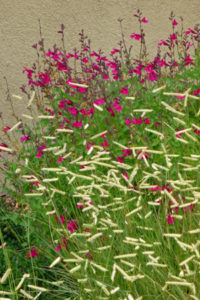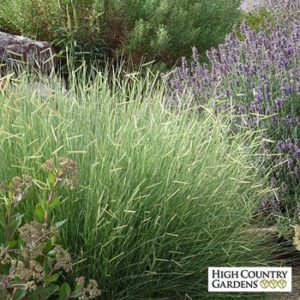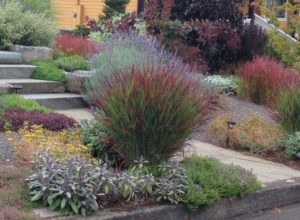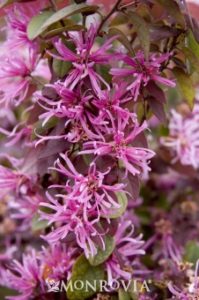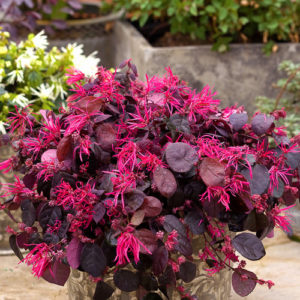Outdoor Living Needed in Grant Park Residential Landscape Design
These Grant Park homeowners just finished updating the stucco exterior of their home and were eager to finally tackle the landscape. The entry was not working at all; it wasn’t clear how to get to front door and the fence was in the wrong spot for curb appeal. They wanted to add beauty and function.
New Front Steps
The old entry had a short concrete wall and an old boxwood hedge. We ripped all of this out and opened up the entire area to maximum curb appeal. The stairs and landing are poured concrete, acid washed. We did not want to change anything about the old Portland charm (or function!) of the Tudor-style portico, so that section of concrete was just updated with paint. Yes, it will have to be re-painted every once in a while. However, it’s almost impossible to match old concrete with new, so a complementary color can be a great solution. A small sit spot makes the front entry feel welcoming.
Colorful Planting Plan
The entry plants have already made a splash in their first year in the ground. Last fall, the neighbors were commenting on how the yellow grass, Carex oshimensis ‘Everillo’, glows in the low autumn light. It is always a joy when our gardens suit our clients and enhance the community at the same time.
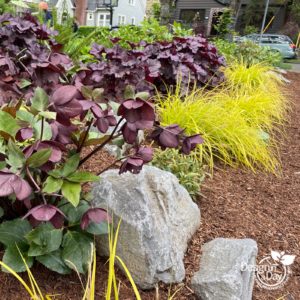
Purple Hellebore blooms from February to May. The yellow grass, Carex oshimensis ‘Everillo’, and Coral Bells, Heuchera ‘Grande Black’, bring color year round and are incredibly easy maintenance.
The entry is part shade and sloping so plant selection is important. (When is plant selection unimportant?) Two Vine Maples, Acer circinatum, flank the new steps, seen in the first picture of this blog. The Sarcococca ground cover brings a lovely fragrance in the winter. Hostas pop up for spring and bloom in summer. Into the fall, the small white blooms of Japanese Anemone ‘Honorine Jobert’ light up the entry.
Corner Lot Conundrum
I love working with corner lots because they almost always require out-of-the-box solutions. This one had a useless extra path and the grass was being used as a cut through for neighborhood kids on the way to school.
We removed the walkway, pushed the fence away from the front door and put in a Lavender Hedge so that the homeowners could reclaim this side yard space. The clients say that this solution has worked like a charm and no one cuts the corner anymore. With a new lawn installed, the side yard lawn can be a play space for the kids.
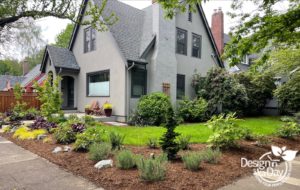
Planting plan for corner lot in Grant Park neighborhood includes a Lavender hedge. It provides evergreen beauty and summer fragrance while gently discouraging people from cutting through the yard.
With the layout of this property, the back yard is small, comprising about a quarter of the total outdoor space. We need all the usable space we can get for the family of four and two big dogs. Therefore, the back is mostly hardscape with plants squeezed in wherever we could get them. The casual crushed rock patio is a comfy lounge area.
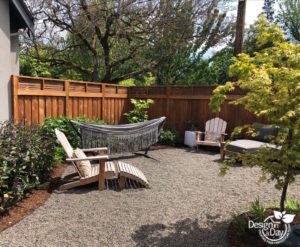
A relaxed collection of different seating- a hammock, a couch and even a raised dog bed make this patio comfortable for the whole family.
The planting plan can take dog traffic – including sword fern, Japanese Forest Grass and the happiest Penstemon I’ve ever seen. The dogs can go to the bathroom on the crushed rock, but these city dog owners are very diligent about frequent walks.
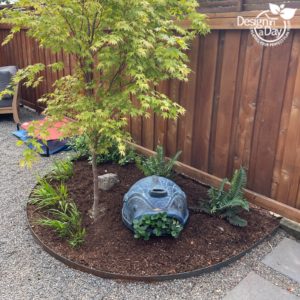
Check out the raised dog bed in the back, lucky pups. Plants include sword fern, Japanese Forest Grass and a single trunk Japanese Maple. Oh, and a fish planter spitting out strawberry plants. Too cute.
The dining table and concrete pad were existing, we just enhanced it with a simple sun sail and some planters to soften the garage wall. A low cost update.
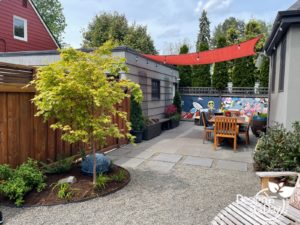
Sun sail is a great low cost way to bring shade and a bit of color to this Grant Park Neighborhood back yard.
Clients Bring the Fun
It’s exciting as a designer for the ideas in my head to become a real-life landscape that a family gets to enjoy. It’s even more joyful when the clients use their outdoor space so much that they add their own flair, like the cloud wall from a past project or the chairs made from whiskey barrels. This family took it up a notch by creating murals that they fixed to the inside of the fence. Although I had nothing to do with this creative work, I couldn’t help but take a picture with the client to celebrate the completion of their landscape.
Contact us today to create a collaborative design that solves all those tricky problems with a corner city lot. We love tricky lots but if your lot isn’t difficult, we are happy to bring our full design abilities to serve your needs. Tricky is not required.

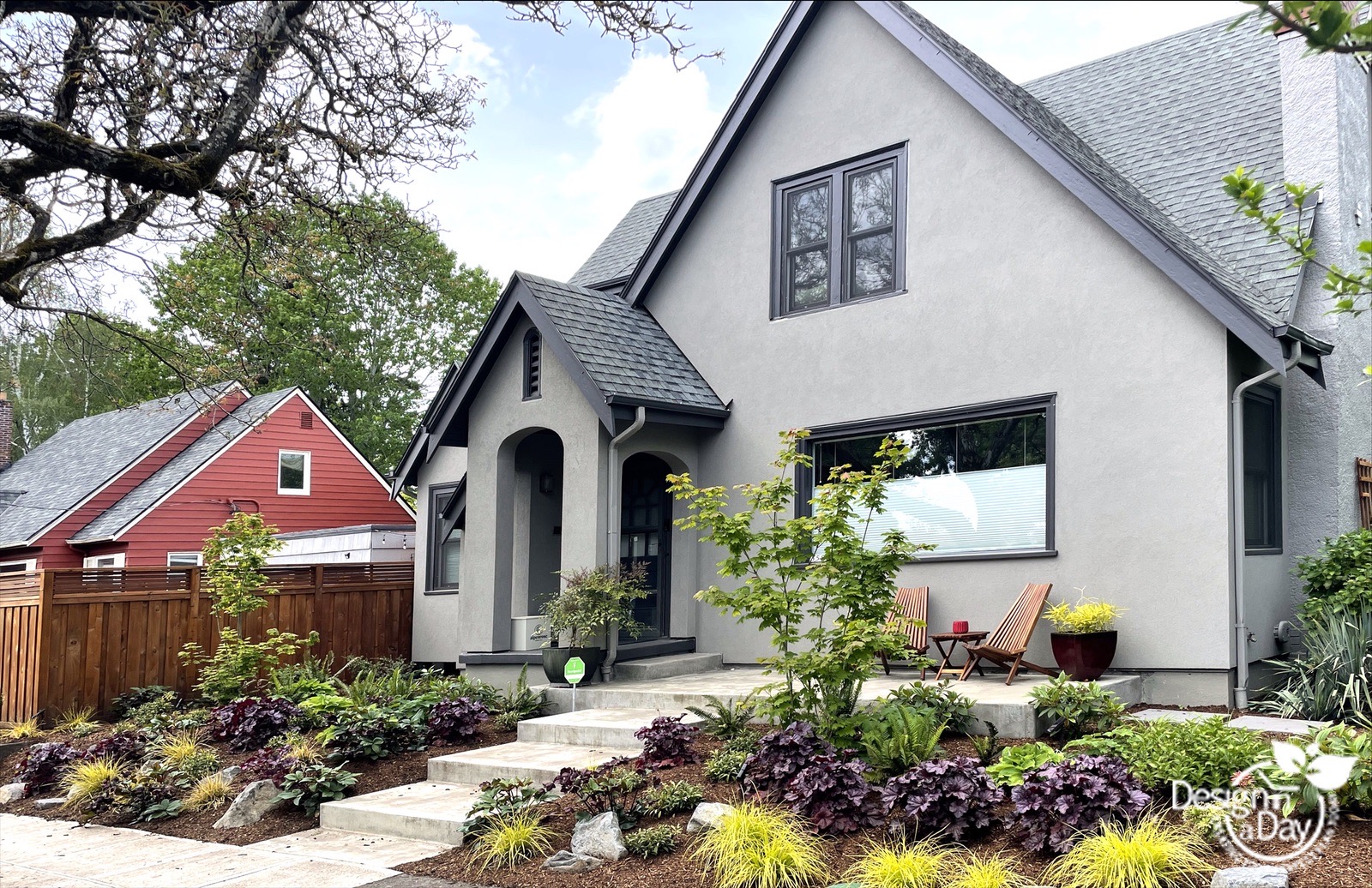
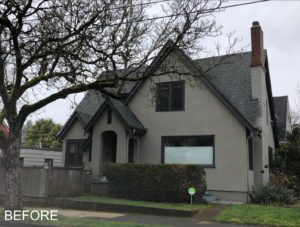
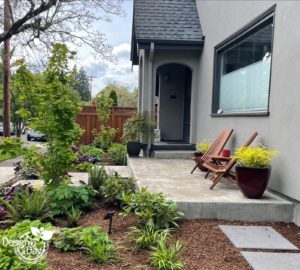


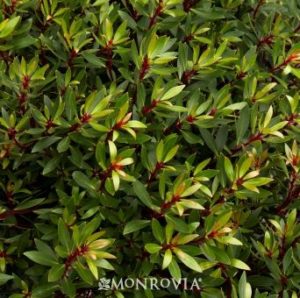
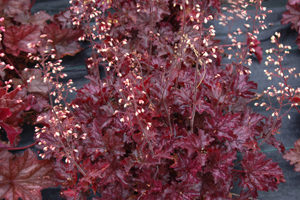 burgundy.
burgundy.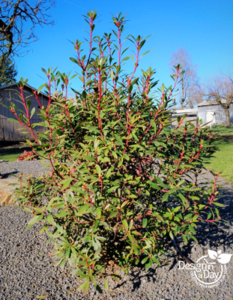
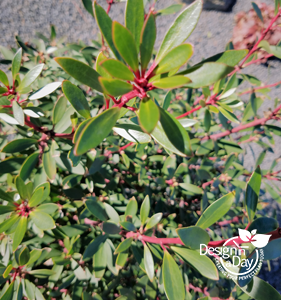 East winter wind
East winter wind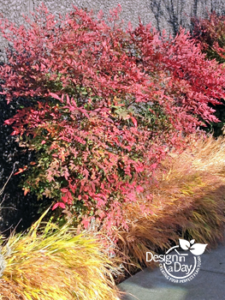 I promised I would follow up from
I promised I would follow up from 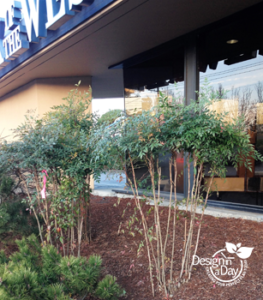 Restore leggy sparse leafed Nandina plants
Restore leggy sparse leafed Nandina plants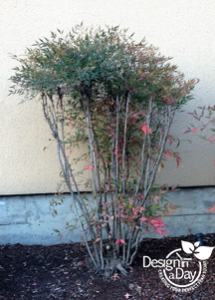 We could correct these ugly leggy Nandinas’ appearance in one year by applying the pruning technique I have illustrated here. These Nandina domestica ‘Gulfstream’ could look amazing with regular irrigation and pruning once every year or two.
We could correct these ugly leggy Nandinas’ appearance in one year by applying the pruning technique I have illustrated here. These Nandina domestica ‘Gulfstream’ could look amazing with regular irrigation and pruning once every year or two.